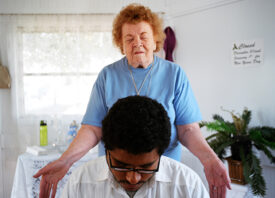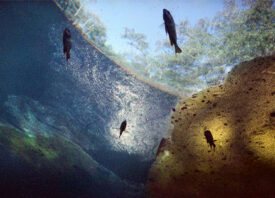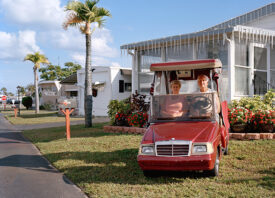Search this site
The Life of a Camera Trap Tech in the Florida Wildlife Corridor

“The way the Florida Panthers moved through the landscape, leaving hardly a trace, fascinated me,” the photographer and camera trap technician George McKenzie Jr. tells me. It’s a sentiment shared by many of the photographers and conservationists who worked on the Path of the Panther project, created to protect wild areas in Florida. In the documentary film, Carlton Ward Jr., the founder of Wildpath, compares the majestic animals to ghosts—there one moment and gone the next.
McKenzie Jr. left his home in Brooklyn, New York, to join Ward Jr., the producer Tori Linder, and the team at Path of the Panther in the Northern Everglades. Once there, he spent his days overseeing a system of camera traps in the Florida Wildlife Corridor, a network of wild and working land spanning eighteen million acres. This connected land is critical for the survival of many species, including the ever-elusive Florida Panther.
Camera traps like the ones McKenzie Jr. worked on have been essential to documenting the movements of wildlife throughout the Florida Wildlife Corridor. “My time camera-trapping revealed the solitary and nocturnal nature of the panthers,” the photographer and technician recalls. “They are masterful predators, and their grace and power are unparalleled.”
At one point, Florida Panthers were on the brink of extinction; today, their numbers have increased to an estimated 200 individuals. During his time working with Wildpath on Path of the Panther, McKenzie Jr. came to recognize certain individuals, including No Ears. This panther got his name from his very small ears—likely the result of fights with other males over territory, which can happen due to habitat loss. “Observing his distinct personality and behavior through the camera traps became a joy and a privilege,” McKenzie Jr. reflects.
And then there was the time he caught a female panther on video, navigating the landscape with her cubs in toe (you can see her in the documentary film). In observing these individuals, McKenzie Jr. saw another side of the mysterious and powerful animals. “They showed me something special, something real tender about these wild creatures,” he tells me. “That one hit me right in the heart.” We asked him to tell us more about his time in the Florida Wildlife Corridor.

You moved to Florida specifically to work on the Path of the Panther project. How did you come across this opportunity?
“I first learned about the Path of the Panther project back in 2019 during a National Geographic Society summit in Washington, D.C., where I had the chance to meet Carlton Ward Jr. and Tori Linder. I was instantly captivated by their passion and vision, and we stayed connected via Instagram. I followed the project closely, deeply resonating with its mission and the stories they were telling.
“One day, out of the blue, I received a random message from Tori Linder. She was looking for someone to fill the role of a camera trap tech in the Northern Everglades. She wondered if anyone in my network might be interested. I dutifully shared the job posting on my social media, but a spark had been ignited in me. After just 24 hours of reflection, I realized I wanted this job. It wasn’t just an opportunity but a calling.
“Determined to seize this opportunity, I threw myself into preparation. That’s when I started my now infamous 4:30 AM wakeup routine, followed by daily gym sessions before 6:00 AM. Every sweat-drenched morning was a testament to my commitment, a physical and symbolic journey toward the path I knew was meant for me. The Path of the Panther was calling, and I was ready to answer.”

Please tell us about the Florida Wildlife Corridor. Do you remember the first time you visited?
“My first experience visiting a part of the Florida Wildlife Corridor from Bed-Stuy, Brooklyn, was a whirlwind of emotions. I was awestruck, scared, and very inquisitive all at once. The landscape was unlike anything I had ever encountered. The sounds of birdsong accompanied every step, forming a symphony that was both foreign and entrancing. Cypress and wetlands filled the air, a distinct and earthy fragrance that seemed to pull me deeper into the wild.
“It was a world teeming with life, an extraordinary place that felt remote and intimate. Everywhere I looked, there were signs of nature’s abundance and complexity. Yet, amid this wonder was fear—a realization of my smallness in this vast and untamed land. But more than fear, there was fascination. I was hooked, drawn to the wild’s call, eager to explore, learn, and become a part of the very fabric of the Florida Wildlife Corridor.”

Can you walk us through a day in your life in the Florida Wildlife Corridor?
“My field days? They started early. Real early. I always packed my gear the day before because being prepared was something I picked up along the way. Breakfast? Usually, just a protein shake or nothing at all. You see, Florida Black Bears have some serious sniffers, and oily fingers from a McDonald’s breakfast once led to a young bear trying to nab my meal right off my camera traps. Lesson learned.
“After getting ready, I’d check the camera traps, exploring different corridor parts. Every day was different; it all depended on the season and what the project needed. Evenings? That was unloading time, returning the equipment, and planning for the next day. It was a routine, sure, but every day had its own surprises. That’s the wild for you. Always keeps you on your toes.”

What are some of the physical and practical challenges that come with working in this landscape?
“Heat and mosquitos were my buddies out there. Always had to have water on hand, and nothing honestly kept those bugs at bay. The land was gorgeous but didn’t play nice sometimes. Tough? Sure, but that’s what I signed up for. Every challenge was just part of the deal, reminding me why I was there in the first place. It was wild, and I wouldn’t have it any other way.”

Aside from the panther, who are some of your favorite wild animals who call this part of Florida their home?
“Gotta be the Florida Black Bear. I had no idea these guys even lived in Florida until I saw one on a camera trap. Mind. Blown. I’ve been digging into their story, and man, they’ve got it rough sometimes. Just a few weeks back, I saw a mom and her cubs while scouting for new camera spots. Seeing them up close like that? It’s a whole different ball game. Makes you appreciate them even more.”

Any other wildlife encounters you’ll never forget?
“There’s Big Tommy, a twelve-foot gator I stumbled upon sunning himself on the side of the trail. I felt my heart stop for a second there, and I shrieked and jumped into my trainer’s lap.”
What challenges did you face while working as a camera trap technician on Path of the Panther?
“Ensuring the camera traps could withstand the elements and making high-quality images was a constant challenge. I’m particularly proud of a trap I customized to capture nighttime behaviors without startling the animals.”

What lessons do you take with you from your time working on Path of the Panther?
“Yeah, that’s the word for it. Working on this project showed me how tough this land and its critters are. It made me realize how everything’s connected, and how it’s on all of us to keep it that way. Being here, doing this work? It’s a game-changer, and it makes you see the bigger picture. We’ve all got a part to play in keeping this place alive and kicking “
How are the Florida Panthers doing now?
“The panthers face ongoing challenges, but there are glimmers of hope. Increased awareness, protective measures, and the resilience of these majestic cats offer hope for their future.”
In Florida, $2 billion has been budgeted for protecting the land in the Wildlife Corridor since 2021. How can the public help to ensure the continued protection of the corridor and others like it?
“Parts of the corridor are protected, but ongoing efforts are crucial. The public can help by supporting conservation organizations, being responsible visitors, and advocating for policies that protect these wild spaces.”

Is there a question you wish I’d asked that I didn’t?
“Yes: Why’d I care so much about this work? Look, it wasn’t just a paycheck. Learning from Carlton Ward Jr. was like going to grad school for what I love. I took that white-belt approach, always learning. Every day, it was about more than just me. It was about being part of something way bigger, something that mattered. That drive? That’s what got me up every morning, hungry to know more about this wild, incredible place.”
George McKenzie Jr. is part of Wildpath, a team of conservationists and storytellers working to protect wild places. Path of the Panther is now streaming on Hulu and Disney+.
Further reading:
• This Overlooked But Magical Kentucky Forest Deserves Our Protection
• A Teen Photographer Races to Protect a Massachusetts Forest
• Rare and Ancient Creatures Revealed in Underwater Photography


